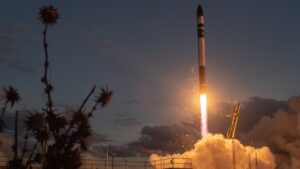During the Jan. 20 launch, Electron’s kick stage placed its payload, a satellite built by German company OHB Group, into a circular orbit at an altitude of 1,200 kilometers. The kick stage fired again to lower the perigee of its orbit by 740 kilometers to accelerate its eventual reentry.
“The last launch was quite a complicated one,” Peter Beck, chief executive of Rocket Lab, said in an interview. Most Electron missions deploy their payloads at an altitude of about 500 kilometers, so the kick stage needed to fire its Curie engine for more than twice the duration of a standard mission. That kick stage carried double the number of propellant tanks to carry out that mission profile.
Neither Rocket Lab nor OHB have released many details about the satellite on that mission, GMS-T, other than it is a “50-kilogram class” communications satellite. Beck, though, said that contrary to some suggestions that GMS-T is for a Chinese company, the satellite is “100% European.” More recent speculation has linked the project to Thales Alenia Space to bring into use spectrum originally intended for LeoSat.
Rocket Lab signed the contract with OHB less than six months before the launch, and Beck said that kind of responsiveness is a key part of his company’s business model. “The type of customer coming to us is looking for that high-reliability white-glove service,” he said. “That kind of customer service is pretty hard to replicate.”
That degree of service, he argued, will set the company apart from both other small launch vehicle companies and rideshare services, like SpaceX’s Transporter-1 mission that launched 143 satellites Jan. 24. SpaceX’s rideshare program in particular threatens to undercut small launchers by offering a steady stream of low-cost launch opportunities.
“Low-cost rideshare has always been available,” he said, with the difference now that it is being offered by SpaceX rather than Russian or Indian launch vehicles. “We still see customers coming to us who just can’t wait.”
The demonstration of the kick stage’s enhanced performance is the first of several milestones Rocket Lab plans for 2021. The next Electron launch, currently scheduled for March, will include the company’s second Photon satellite along with several commercial payloads.
Beck said Rocket Lab will use the Photon to perform testing to prepare for its launch of NASA’s Cislunar Autonomous Positioning System Technology Operations and Navigation Experiment (CAPSTONE) mission to the moon, which will use Photon as a translunar injection stage. “The maneuvers for the CAPSTONE mission are very, very difficult,” he said. “This is all about building heritage on components and processes.”
CAPSTONE is scheduled for launch in the second quarter on an Electron flying out of Launch Complex 2 in Wallops Island, Virginia. That schedule depends on final NASA certification of the autonomous flight termination system for the rocket, a process that has been delayed for months. Beck said the company was still hopeful that the system will be approved in time to keep the launch on that schedule.
Rocket Lab also plans to open a second pad at Launch Complex 1 in New Zealand in the second quarter. Beck said the strongback structure will be installed on the pad “relatively shortly,” followed by final commissioning.
The second quarter will also see Rocket Lab’s second attempt to recover the Electron first stage. The company recovered the first stage from a Nov. 19 launch and has since been testing the stage and its components.
That second recovery attempt will be “essentially” the same as the first one, he said, with the main difference being an improved heat shield at the base of the rocket. The company knew the existing heat shield wasn’t sufficient to protect the stage enough to enable reuse, but wanted on the first flight to see how much extra protection is required.
“The heating condition was really good,” he said of the November flight, “but we want to lower the heating a little bit more.” Engineers have cut up the first stage to perform testing, including to see how the carbon composite structures reacted to “transient excursions into high heating” during reentry. “The results look really good right now, but the lower the heat load that we can put on the stage, the better.”
Beck said that some components of the stage, such as avionics and electrical systems, “are as good as the day they flew.” Those have been requalified and, in some cases, installed on other vehicles being assembled for future launches.
“We’re hoping to have multiple recoveries this year,” he said. “The goal I’ve set for the team for this year is that, by the end of the year, we want to get one back that is in the condition to refly. We may not get it reflown, but we’re at least going to get one back in a condition that is good enough to refly.”



